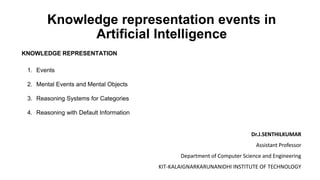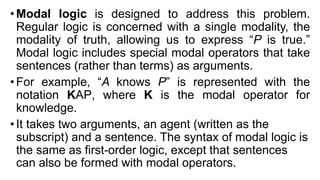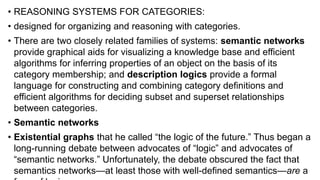The document discusses knowledge representation in artificial intelligence, emphasizing events, mental events, reasoning systems, and categories. It presents a framework for organizing these elements, utilizing time scales, modal logic for reasoning about knowledge, and semantic networks alongside description logics for categorization. Additionally, it addresses nonmonotonic reasoning, highlighting how beliefs can change with new evidence, through methods like circumscription and default logic.








![•That means that modal logic can be used to reason
about nested knowledge sentences: what one agent
knows about another agent’s knowledge.
•For example, we can say that, even though Lois
doesn’t know whether Superman’s secret identity is
Clark Kent, she does know that Clark knows:
•KLois [KClark Identity(Superman, Clark ) ∨
KClark¬Identity(Superman, Clark )]](https://image.slidesharecdn.com/knowledgerepresentationeventsinartificialintelligence-231102043832-182ff9e0/85/Knowledge-representation-events-in-Artificial-Intelligence-pptx-9-320.jpg)






![• This link asserts that
• ∀x x∈ Persons ⇒ [∀ y HasMother (x, y) ⇒ y ∈ FemalePersons ] .
• We might also want to assert that persons have two legs—that is,
• ∀x x∈ Persons ⇒ Legs(x, 2) .
• The semantic network notation makes it convenient to perform
inheritance reasoning.](https://image.slidesharecdn.com/knowledgerepresentationeventsinartificialintelligence-231102043832-182ff9e0/85/Knowledge-representation-events-in-Artificial-Intelligence-pptx-16-320.jpg)


